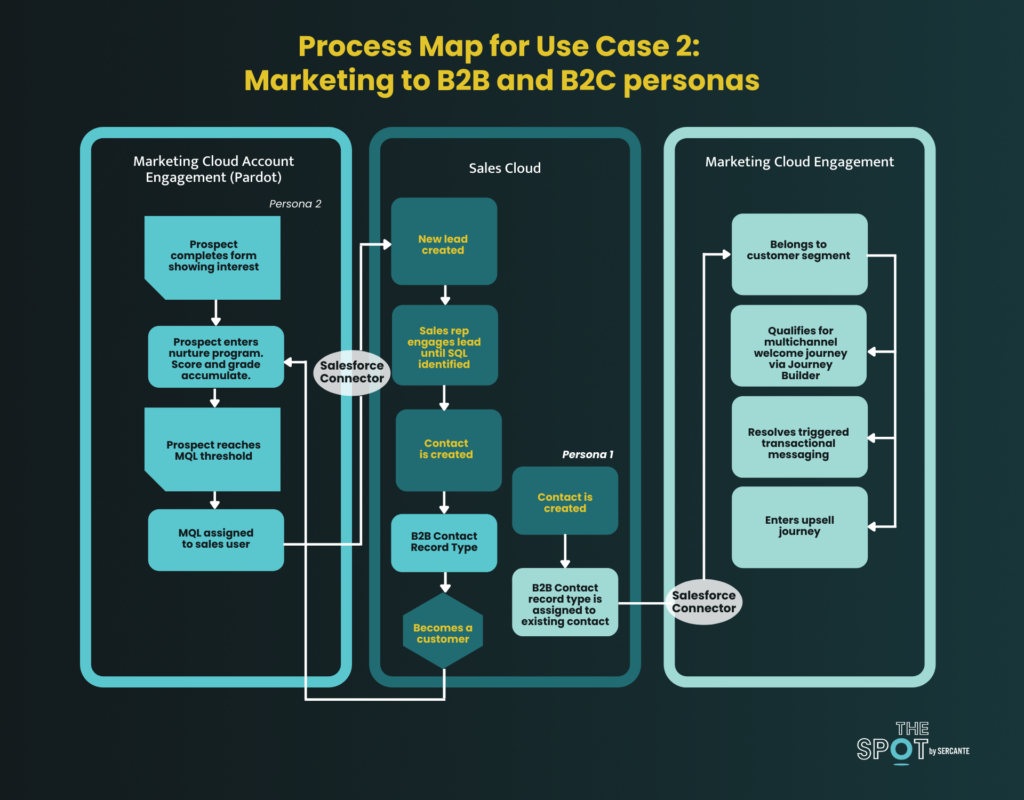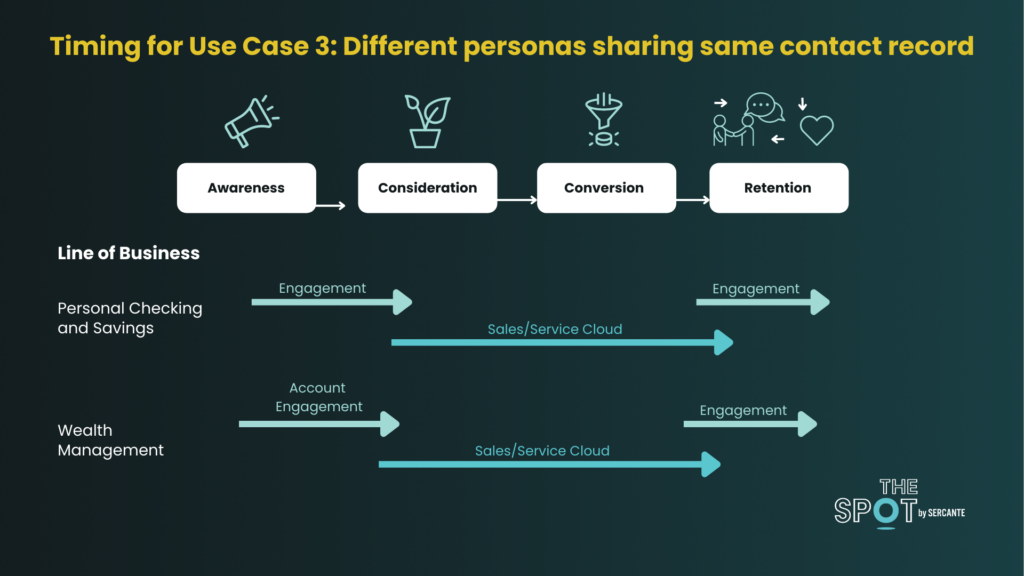Have you ever wondered why sales and marketing teams combine Salesforce Marketing Cloud Engagement and Account Engagement (formerly Pardot), with Sales Cloud to reach their goals?
Thinking about how these platforms can work together likely makes your head spin like a twister in Kansas.
But, fear not! In this edition, we’ll provide more clarity than confusion.
We’ll go through a high-level overview of how Salesforce Marketing Cloud Account Engagement (formerly Pardot) and Marketing Cloud Engagement compare. But, this isn’t a versus and when to choose which (c’mon we’re all family!).
We’ll devote the majority of this blog highlighting three use cases that unlock success using both Salesforce marketing automation platforms integrated with Sales Cloud.
How do Marketing Cloud Engagement and Account Engagement compare?
If you’re familiar with these platforms, then you know they’ve traditionally been focused on industry (B2B vs B2C) and platform-specific features. While a lot of the unique needs of these industries remain true, the lines and approaches of how to communicate digital across these audiences (which are sometimes shared across a business) continue to blur.
Below is a tried-and-true Venn diagram that shows the overlap as well as their differences.

Features that are unique to each, such as scoring & grading from Account Engagement (Pardot) and mobile messaging in Engagement are the key differentiators.
Why do marketing teams use both MCAE and MCE?
B2B marketers are now looking to execute more complex multi-channel messaging once a prospect converts to a customer, for example, and therefore justifies the need for both solutions.
There are also more and more instances of B2C or D2C driven organizations that serve two very unique personas and different contacts — tne that focuses on the traditional multi-channel messaging approach and one that would benefit from lead scoring, nurturing, and more 1:1 guided selling. In this case, also, the argument for both platforms can make sense.
And lastly, there’s the more complex instance where an organization serves two very unique personas, yet the personas apply to a single, shared contact.
Today, we’ll focus on the following:
- A traditional B2B org looking to execute more complex multi-channel messaging post-conversion
- A multi-business model organization with two unique personas
- A multi-business model organization with two unique personas that share a contact
Use Case #1: A traditional B2B org looking to execute more complex multi-channel messaging post-conversion

As described above, we’ve got a traditional B2B tech organization focused on a single persona that typically only applies to one contact record type. They’re looking to adopt more complex multi-channel messaging once their prospects become a customer.
The ability to acquire leads, score and nurture until an MQL threshold is reached and sales can step in is still critical and at the heart of this organization’s business model. However, the ability to retain and engage with their customers in a competitive marketplace is of ever-growing importance.

In this scenario, the prospect will be acquired via an Account Engagement form.
- They’ll be nurtured through email, forms, and landing pages powered by Pardot until their MQL threshold is reached.
- Upon reaching, the MQL will be assigned to a Sales user and created as a new lead in Sales Cloud.
- The Rep will work the lead until SQL status and from there will convert the lead and create an opportunity thereby also triggering the contact creation process.
- Once the opportunity is closed won, the contact is now eligible for customer marketing in Journey Builder via the Marketing Cloud Connector.
Use Case # 2: A multi-business model organization with two unique personas

A hospital technology organization has two business models that support two separate personas that do not overlap. In this scenario, because of the way the organization is structured a single persona and contact is messaged only from Engagement or Account Engagement (Pardot). There is no sharing of contact and messaging between these solutions, and it’s therefore more straightforward.
The emphasis for this use case is on how you can use both platforms to support the unique needs of your personas and overall business.

For Persona 1
- A buyer makes a purchase and becomes a customer; a salesperson isn’t involved in this transaction.
- As a new customer, a contact is created as a person account record in Sales Cloud.
- Now the person account is available in Engagement via Marketing Cloud Connect and customer marketing can begin in Journey Builder.
For the Persona 2
- The prospect will be acquired via an Account Engagement (Pardot) form.
- They’ll be nurtured through email, forms and landing pages powered by Pardot until their MQL threshold is reached
- Upon reaching, the MQL will be assigned to a Sales user and created as a new lead in Sales Cloud.
- The Rep will work the lead until SQL status and from there will convert the lead and create an opportunity thereby also triggering the contact creation process and the contact is created with a specific record type: B2B Contact.
- Marketing Data Sharing rules in Pardot are configured to ensure that only those contacts with the B2B record type sync with Pardot.
- The prospect in Pardot has a bidirectional syncing relationship with the contact in Sales Cloud.
- And when the existing customer, still syncing to Pardot, expresses interest in another product or service, the B2B marketing team continues marketing to this customer using features in Pardot like email nurturing, scoring, grading, and sales team alignment.
- As it progresses from MQL to SQL, another opportunity can be created on the existing contact record.
Use Case #3: A multi-business model organization with two unique personas that share a contact
Now this scenario is a bit tricky and is really where all the magic needs to happen – we’re tackling not only different personas that leverage both platforms but also share the contact.
Take a financial institution, for example, that has 2 lines of business: Personal Checking/Savings and Wealth Management. The Personal LOB (line of business) is very much a self-service model, while the Wealth Management LOB is exactly the opposite of self-service, yet they both have a common, shared customer/prospect.
You may ask yourself, ‘do they really have the same target audience/segment?’ While your first gut reaction may say, ‘No, ’ which is true, it’s also partly true that these different buyer personas can have crossover and can in all actuality apply to the same single individual.
Furthermore, the ability to convert and increase the CLV (customer lifetime value) by taking a Personal Checking/Savings customer and upselling your institution’s Wealth Management services is a very strategic and much-desired result in the banking world. The key to successfully achieving this is all in your approach.

Let’s think through this from a basic customer journey perspective.
- In this case above, the potential customer gains initial awareness and exposure of the Personal Checking/Savings product through lookalike audience modeling fueled by Marketing Cloud Engagement & Advertising.
- They then visit the website to apply for an account, receive approval, and have now converted to a Personal Checking/Savings customer.
- Upon conversion, they become a contact (and Person Account record type) in Sales Cloud which is bi-directionally synced to Marketing Cloud Engagement via MC Connector. They are now eligible to be enrolled in various customer journeys — the first obvious one being a Welcome Onboarding Journey.
- Throughout their relationship based on their activity and inactivity, they will qualify for other journeys such as Upsell and Cross-sell. For argument’s sake, let’s say as part of one of these journeys they click on a cross-sell content piece focused on wealth management.
- They visit the website and fill out a wealth management form. They are then also marked as a B2B Contact Record type, and they’ll be nurtured by Pardot until their MQL threshold is reached
- Marketing Data Sharing rules in Pardot are configured to ensure that only those contacts with the B2B record type sync with Pardot.
- Upon reaching the MQL, they will be assigned to a Sales user for 1:1 outreach. As it progresses from MQL to SQL, another opportunity can be created on the existing contact record.
- Once the Sales user converts this prospect and opportunity to Closed Won, they will now become part of the wealth management customer segment in Marketing Cloud Engagement and will likely enroll in one more many customer relationship journeys across the tenure of their relationship.

In summary, the banking institution is leveraging Salesforce Marketing Cloud Engagement for full lifecycle management including awareness of its self-service line of business. For its more considered purchase model line of business, Account Engagement (Pardot) is used. However, once these prospects convert to customers, the ongoing customer relationship communications, like SMS messaging, will occur through Marketing Cloud Engagement.
Closing Thoughts
As you can see, the potential use cases can range from simple to complex. Therefore it’s important to understand the long-term plan of what you’re trying to achieve to ensure what you’re building today can scale and grow for the future.
A partner who has breadth and depth of experience in both platforms as well as the know-how to be future-proof, especially for organizations that have more than one business model, is an ideal next step.
What other use cases can you think of for these platforms? Let us know in the comments!









